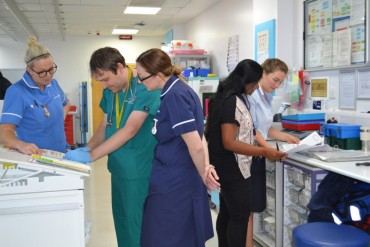What is Serial Casting?
- Serial casts are used to give a long stretch to muscles and tendons that have become tight or shortened.
- The aim is to hold the ankle and foot in the right position for a long time using plaster of paris and / or other casting bandage.
- Casts will be changed at a minimum once a week to check the skin and to gain an improved position of the foot.
- For children who are walking, the casts help to re-educate the walking pattern.
- Your Physiotherapist will discuss treatment with you and your child’s Consultant before any casting is started.
- Due to the change of position and the stretch of the muscle, your child may experience some initial discomfort.
- If this lasts or is accompanied by any other problems, you must contact your Physiotherapist or one of the other contact numbers given overleaf.
The amount of time spent in a cast and the frequency of cast changes will be decided by your child’s Physiotherapist taking into account:
- your child’s tolerance of the casts.
- the amount of increased movement needed.
- the ease with which shortening responds to treatment.
Casts may be used for up to 4-6 weeks, but often less time is required. This depends on response to casting and also time for splint/s to be made (if required).
Each time the cast is removed, the foot position will be re-assessed and the next step of treatment planned.
A splint may be made during the casting period, to be worn after the last cast is removed. This will depend on your child’s specific needs.
There is a small possibility that your child may need serial casting again in the future. However this will be discussed with you and the reasons why at that time.
- Allergy – rash, itching etc.
- Circulatory problems – colour change.
- Pressure sores.
- Skin breakdown.
- Slipping and falling if cast shoes not worn.
- Some discomfort after casts removed which may affect your child’s walking at first.
There may also be some problems with putting the cast on and taking it off. These should be explained to you by the team at Victoria Hospital, Blackpool.
Children can usually continue with their daily routine of activities, except for activities which will get the plaster wet e.g. bathing or swimming. However if you are unsure about a particular activity please discuss it with your Physiotherapist.
You will be told how long to wait after the cast has been put on before your child can walk or stand on it.
You may also be given extra activities to exercise the other muscle groups, which aren’t in the casts.
It is important that you check the casts frequently during the first day and then at least once a day for as long as the casts are on.
You will be shown what to look for, and these will include:
- Circulation in the toes i.e. changes in skin colour or temperature, swelling or the cast becoming tight.
- Sharp edges at the top and bottom of the cast.
- Rashes.
- Abrasions or rubbing.
- Signs of cast slipping off
Please do not:
- Allow the skin or cast to become wet.
- Insert anything into the cast to scratch.
- Allow anything to fall into the cast, e.g. sand.
- Allow your child to walk without wearing the cast shoes.
Version control:
Author: Fiona Simpson
Approved by: Child Health Meeting
Date of publication: 19/06/2024
Reference No: PL/966 (V4)
Review date: 01/06/2027



